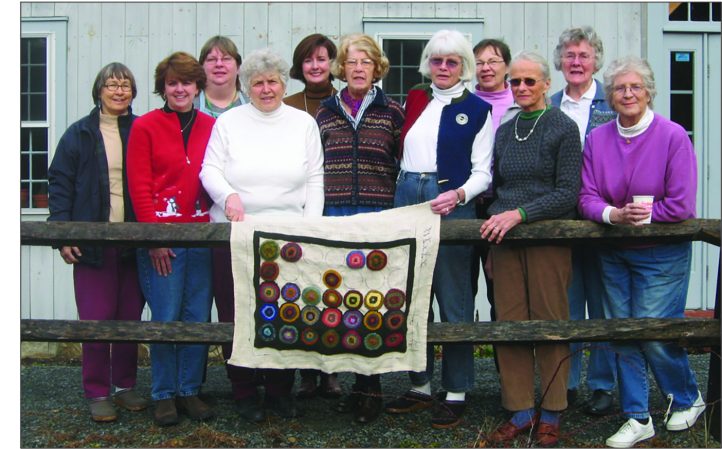
The Duxbury Rug Hookers, Duxbury, Massachusetts
Community involvement has always been a part of my life. I have been active in clubs and served on committees ever since I was a young girl—it is just part of who I am. As an adult, not only has rug hooking become a huge part of my life, but it also has developed into a career. Over the past 15 years I have found that the art of rug hooking, and community involvement have blended together. When we are lucky enough to have something, such as an art or craft, that we are passion-ate about, it is easy to use it to become involved in our commu-nities. It helps to make them richer, healthier places in lots of ways.
A Social Activity
For some people rug hooking is a creative outlet; for others it is a way to keep their hands busy. For a craft that has rich traditions of women working alone in the kitchen beside the fire making a rug, it has blossomed into social network of people that knows no boundaries. Groups may meet online to share ideas, or sit together at the parish hall sharing wool or stories about their adventures. You need only to look in the back of this magazine to learn of the many events and gatherings that take place around the globe that center on rug hooking. Through this hobby people have built networks of support.
How many times have you heard a new convert exclaim, “Rug hookers are the nicest people!” Well it’s true, and my research for this article has once again proven to me that rug hookers are often very giving, caring people who want to spread the joy they have gotten from the craft with others. Many have a strong social conscience; others have a deep need to share with others the soothing, calming effect that hooking rugs has had in their own lives. I have met many people who told me that they worked through many personal issues thrumming their hook, and getting lost in bundles of color. In my research I have found that groups all over North America and beyond are recognizing the importance of rug hooking in their communities and using it as a tool to give back to those very localities.
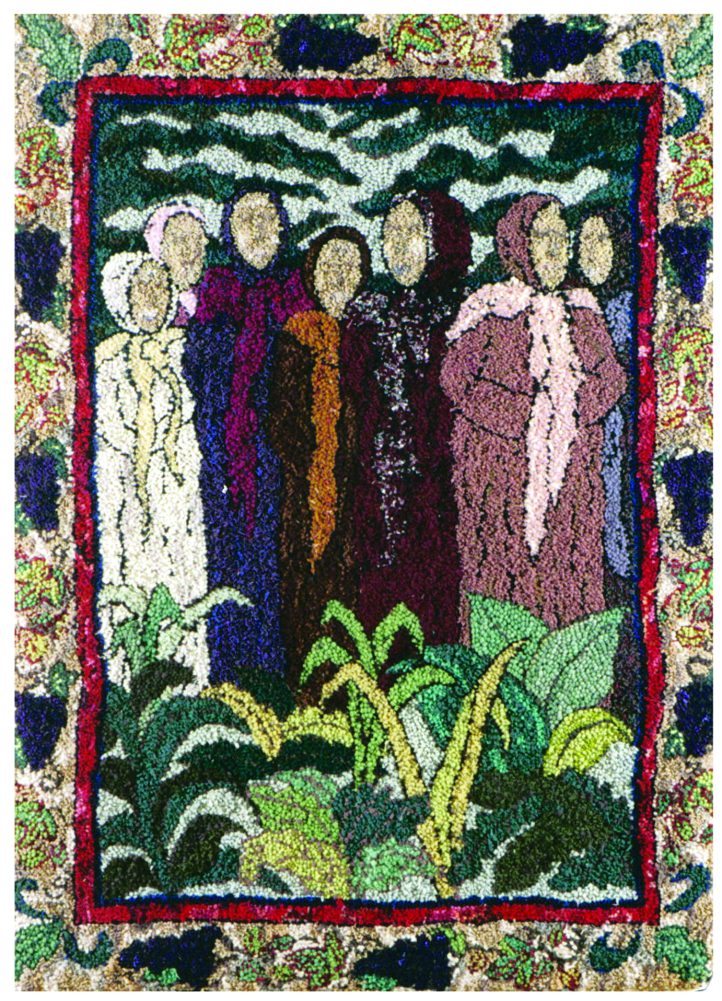
SEVEN SISTERS, 4′ x 6′, #6- and 8-cut wool on burlap. Designed and hooked by Deanne Fitzpatrick, Amherst, Nova Scotia, 1997.
The Duxbury Massachusetts Rug Hookers
Many people are using rug hooking to create, develop, and build community in healthy, therapeutic ways. Sometimes it is as simple as gathering together as a group to hook and do a little fundraising. The Duxbury Rug Hookers, a group of about 25 women, meet once a month in the Alden Kindred Barn. The Alden Society maintains this barn and the original house and property of John and Priscilla Alden. Tours are available to the public and the barn is available for community programming. The Alden kindred number more than a million people and are the descendants of John and Priscilla Alden. Each year the Duxbury Rug Hookers create a rug communally, which raises between$1000 to $2000 for the society. In addition, this year they hosted a show of their rugs in the local library raising $400 for the purchase of craft books. Olga Rothschild, a member of the group said, “The communal rug builds a sense of togetherness which is often lacking in modern life.”
This group, like many others, meets for the joy of it, but they are also giving back. Hosting a show of hooked rugs offers an experience for people to come and see the beauty of the craft, as well as a chance to raise money for library books that they, as well as everyone else, get to enjoy. Secondly, they are giving back to the society by providing them with a place to meet.
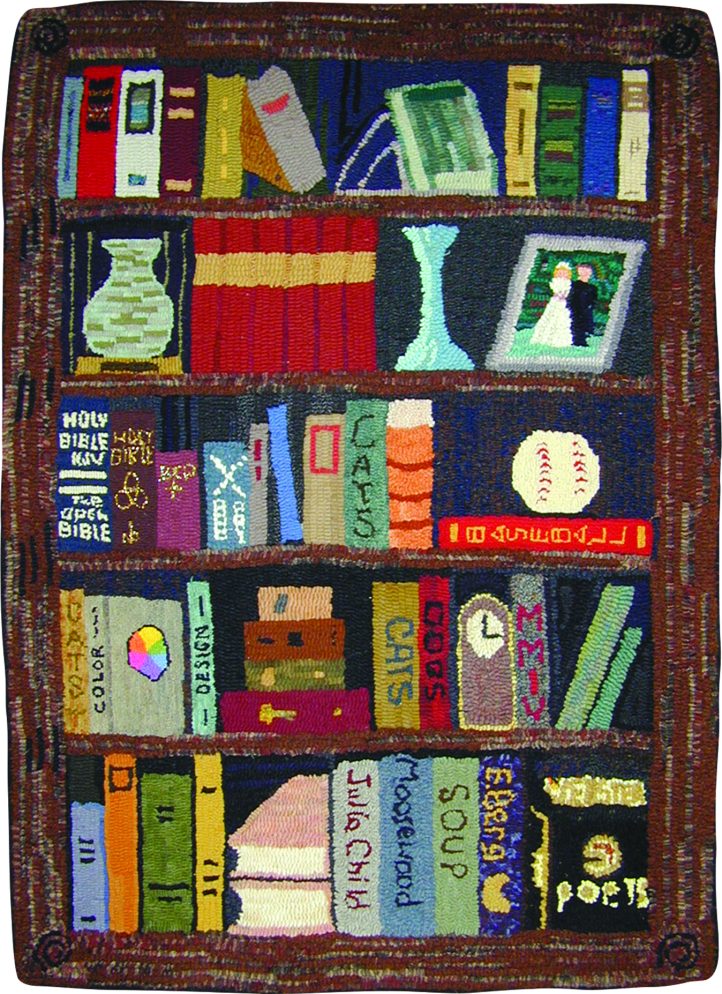
THE LIBRARY RUG, 27″ x 38″, #3-8 cut wool on linen. Designed and hooked by The Duxbury Rug Hookers, Duxbury, Massachusetts, 2004.
Rug Hooking and Mental Health
Far across the Atlantic in England, Priscilla (Cilla) Cameron is busy at work creating community through rug hooking. Over the past years she has worked with mental health patients, as well as teaching rug hooking to learning disadvantaged students. “Men and women taking part in these projects may have poor social skills, little ability to write or use rug making tools, difficulties in taking part in group projects, and very low concentration levels,” says Cilla. “As an artist/teacher one must very quickly make clients feel comfortable. It can take some time for them to have confidence in you and not see you as yet another person from the system trying to analyze them.” Cilla asks her clients to work in twos or threes and draw or write their favorite things. Next they collate the words and pictures into designs by making templates. With a sheet of paper the size of the rug, everyone decides where to place the templates to build the pattern, and finally, they draw around the templates and transfer the pattern to Hessian (burlap). All participants create samples to practice the technique of proddy. “Most people in England who made rugs from rags used the proddy method and are not so familiar with hook-ing,” she says. Cilla explains that one woman was very withdrawn and never spoke to anyone. She surprised her caretaker when she started to talk about the rug making in her home as a child. “She grabbed the tool from me and proceeded to give a demonstration of how things were done in her day. It really was an amazing happening.”
Many people are using rug hooking to create, develop, and build community in healthy, therapeutic ways.
Cilla finds that it is best to sew the rug onto a large frame so that three or four participants can sit and work together in a relaxed atmosphere where the stories flow freely. She has found that the creation of a rug makes the participants proud, helps develop social skills, builds confidence, and brings along lots of fun and laughter. This type of work has become a very satisfying part of her career as a professional rug hooking artist and teacher.
The West Virginia Church Project
Susan Feller, of Ruckman Hill Farm, Augusta, West Virginia, has used rug hooking in several different ways to become more involved with her community. Initially she was enchanted when she saw Linda Ratcliffe demonstrating rug hooking in Romney, West Virginia, during a local open house. Together they worked with their minister at the local Methodist church to enhance the sanctuary and complement the beautiful stained glass windows in the church. They created an 8′ x 3′ rug, the same size as the windows, to depict the history of the church. Susan designed the rug into panels and also dyed the wool for the rug, while Linda hooked it. In addition, another church member, Mary French Barby, hooked the paramounts—panels that hang over the lectern at the front of the church which depict the liturgical sea-sons. Together, these rugs, along with the stained glass, have enhanced the beauty of the church, adding yet another spiritual dimension to a sacred place.
A second community project that Susan was instrumental in developing was with a group of New Jersey Girl Scouts and Brownies. “I walked into a room of screaming girls, and left a group of rug hookers as quiet as church mice,” says Susan. The Brownie leader, Lisa Minns, has just begun working with the girls to create beginner kits to sell as a fundraiser for both the Girl Scouts, and as part of an outreach program to the children of women who reside at the local women’s prison.
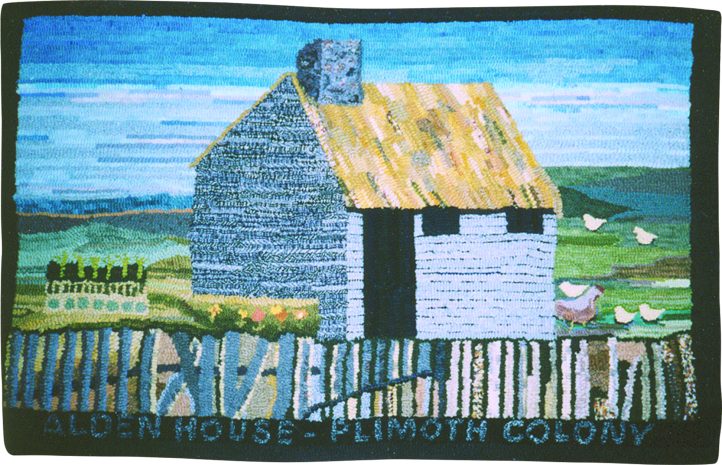
ALDEN HOUSE—PLIMOTH COLONY, 28″ x 20″, #6-8 cut wool on linen. Designed by Olga Rothschild and The Duxbury Rug Hookers. Hooked by The Duxbury Rug Hookers, Duxbury, Massachusetts, 2004. PHOTOGRAPHS BY PEG IRISH
Sharing an Understood Art
Years ago when I first started hooking rugs, I met Anne Johnson, the director of The Drew, a nursing home in New Brunswick, Canada. I was impressed with a project that she had developed for both the home and the residents.
For many years In Atlantic Cana-da, rug hooking was one of the few ways a woman could decorate her home. It was an inexpensive craft that even the wives of subsistence fishermen and farmers could afford. Anne decided that she would use rugs to decorate the halls of the nursing home. When residents moved in, she would offer them or their children the opportunity to hang the hooked rugs they had around their homes as art in their new home. This provided an opportunity for the residents to feel comfortable in their surroundings. She also helped establish the value of the rugs as art and to preserve them for the community. Many of these rugs would have been lost or destroyed if she had not seen their cultural importance.
Anne adds, “The value of and the interest in the mats has certainly increased in the past 25 years and a generation of residents and staff have shared this environment. We asked ourselves if these items would continue to be important to subsequent generations or if the décor would become “dated” and disposable. In a very small way we think we have created a museum or art gallery and have consequently preserved important aspects of culture and heritage for the enjoyment of those that live and visit at the home. We want to believe these items will continue to be appropriate and valued.”
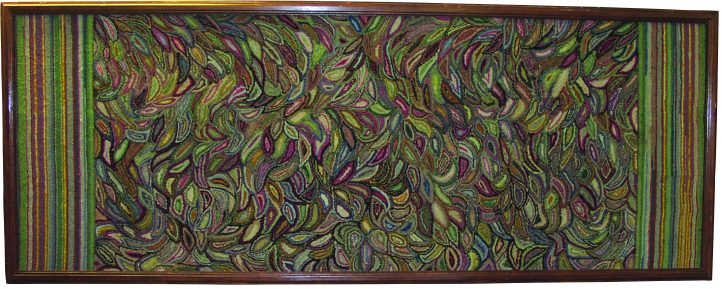
Hooked rug contributed by residents at Drew Nursing Home, New Brunswick, Canada. PHOTOGRAPH COURTESY OF LINE GODBOUT
The Mayo Clinic at Rochester, Minnesota
Last year a nurse from the Mayo Clinic called to order a rug hooking pattern, and as is sometimes the case we got to talking about rug hooking and the programs that are offered by the Women’s Cancer Program at the clinic. A few days later I got an email from Romayne Thompson, an occupational therapist at the clinic, with a kind note telling me how much she liked the rug that had appeared in Mary Sheppard Burton’s book, A Passion for the Creative Life. As it turned out this rug, called The Seven Sisters, is one I created in the mid-1990s celebrating my six sisters, of which I am the youngest. I had kept the rug as I could not sell it but I also could not give it to one of my sisters, or I would have five others mad at me. I enjoyed it for years and wanted to see it hanging in a public space. When Romayne told me about the fantastic programs around art and craft and healing that were taking place at the clinic I knew that the rug would have a good home there. I liked their philosophy that arts like quilting and rug hooking could be therapeutic in both a physical and emotional way for cancer patients.
Romayne decided to take up rug hooking herself and to have a rug set up at the clinic for patients to work on. A great deal of research done over the years shows the benefits of using art as a healing tool, and it also shows that the clinic was moving forward in this direction. “Returning persons to wholeness after the shock of cancer often demands a new approach on the part of the survivor and of the persons in the circles of their lives,” says Anne. “It is our hope that by bringing old and new art forms into their lives we can help them to discover or rediscover interests that help them in personal expression, to enhance their daily lives as they deal with the changes they have experienced,” says Anne.
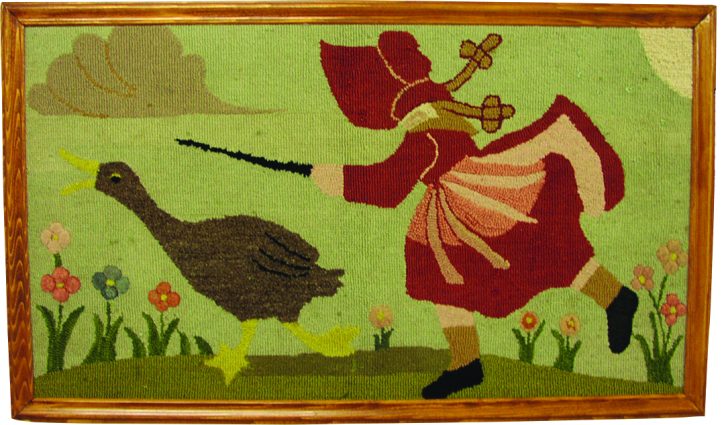
Hooked rug contributed by residents at Drew Nursing Home, New Brunswick, Canada. PHOTOGRAPH COURTESY OF LINE GODBOUT
Women at the Pit Head
Springhill, Nova Scotia is perched, as its name suggests, on a hill in the center of Cumberland County, Nova Scotia, surrounded by miles of spruce woodland and blueberry fields. It is famous for being the hometown of Anne Murray, the internationally famous singer. Sadly, it is also famous for mining disasters, in 1891, 1956, and 1958, which claimed the lives of 443 people from this small community. Many people living in Springhill today remember the 1950s and the rescue operations that took place to save the miners trapped underground. Having lived in this area for over 20 years, I had it in my mind for a long time to create a mat commemorating the mining history of Springhill. Over the past five to seven years I noticed that rug hooking was becoming a big part of community life in Springhill with two groups meeting during the day and an evening group. In a community of approximately 3,500 people, there were about 50 or more rug hookers. I spoke to Bea Hatfield, who has hooked many rugs, to see if she thought the women she hooked with would be interested in carrying out such a project, and I offered to help in any way I could. She invited me to come to their meeting and propose the idea. I thought that to be an authentic tribute, it would make sense if the Springhillers themselves were the ones to carry out the project. They readily agreed. At our first meeting, Bea had brought along copies of the Halifax Herald documenting the explosions. On one of these yellowed fragile pages we saw a picture of the wives of the miners, waiting at the pithead for news of their husbands who were trapped underground. Immediately we came to a consensus that this was the subject we would use to carry out the project. The women of Springhill decided that they wanted to commemorate the strength and dignity of the women whose lives were affected by the disaster. There were many widows in Springhill who raised families on their own having lost their husbands too early to the mine. It made sense to the rug hookers to acknowledge these members of their community with a hooked rug.
The Springhill Hookers have agreed that the rug will hang in the new Dr. Carson and Mrs. Marion Murray Community Center. The rug is still in progress, but will be completed this winter. They have done a beautiful job honoring the women in their community who waited, strengthened their relationship with one another, and their community will be graced with a meaningful piece of art.
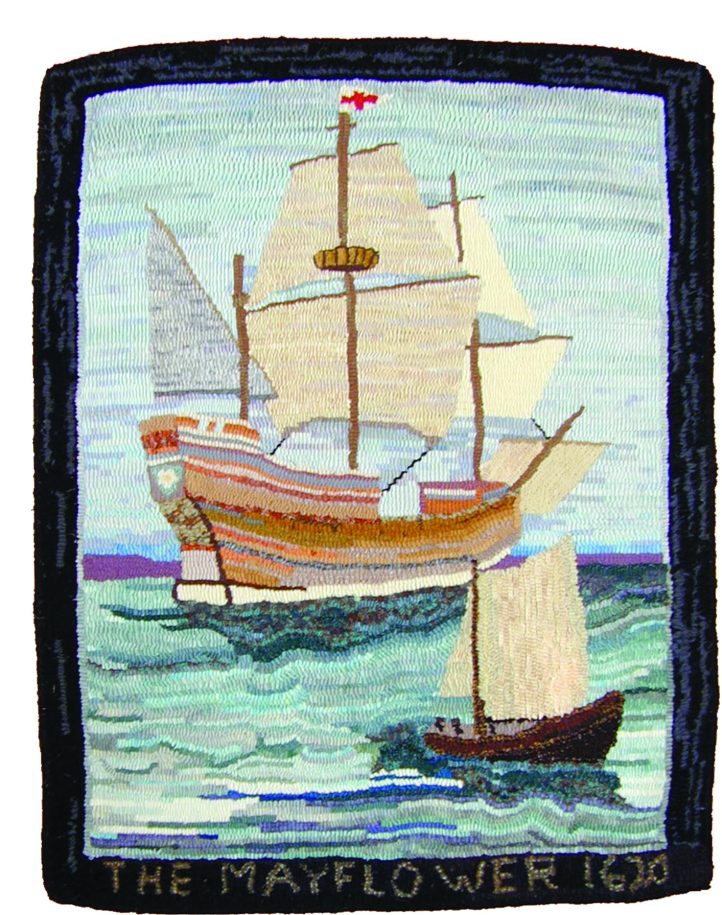
THE MAYFLOWER, 24″ x 30″, #3-8 cut wool on linen. Designed by Brooks Kelly. Hooked by The Duxbury Rug Hookers, Duxbury, Massachusetts, 2003.
Sustaining the Art of Rug Hooking
I believe that one of the ways to preserve rug hooking for the future generations is to teach children how to hook. Together with their rug hooking group, Les Hooke uses au Bor-De-Lo, Line Godbout, and Danielle Oulette coordinated a project that married teaching watercolor, Acadian legends, and rug hooking to 150 children in their community. Their group went into the schools and told the children an Acadian legend. The children would immediately paint their story, and then members of the group would transfer the 12″ x 12″ drawings to burlap for the children to hook. Together they created a show to hang at the Capital Theatre Art Gallery in Moncton, New Brunswick. It will also travel to Fredricton, the capital city, where it will be hosted at The New Brunswick Lieutenant Governor’s residence. At the opening of the exhibit at the Capital Theatre, which was attended by over 300 people, I saw a community bubbling over with excitement. The children were excited by their work, the parents were proud, and Les Hookeuses au Bor-de-lo had a sense of accomplishment.

Rug Show at the Capital Theatre Art Gallery, Moncton, New Brunswick. Line Godbout and Danielle Oulette and their group, Les Hookeuses au Bor-de-lo coordinated this project with 150 school children in their community to combine Acadian history with rug hooking.
The group also decided to create a series of cards and prints of the mats created and they donated over $1000 in proceeds from the cards to charity. Line Godbout said, “This has been a very positive and uplifting experience. From the beginning, there was magic underneath all aspects of this project and it seemed to take on a life of its own. The initial idea just bloomed into many different components, with everything just falling easily in place. But the energy was there because we were so motivated and proud to show not only our work, but also the children’s artwork.”
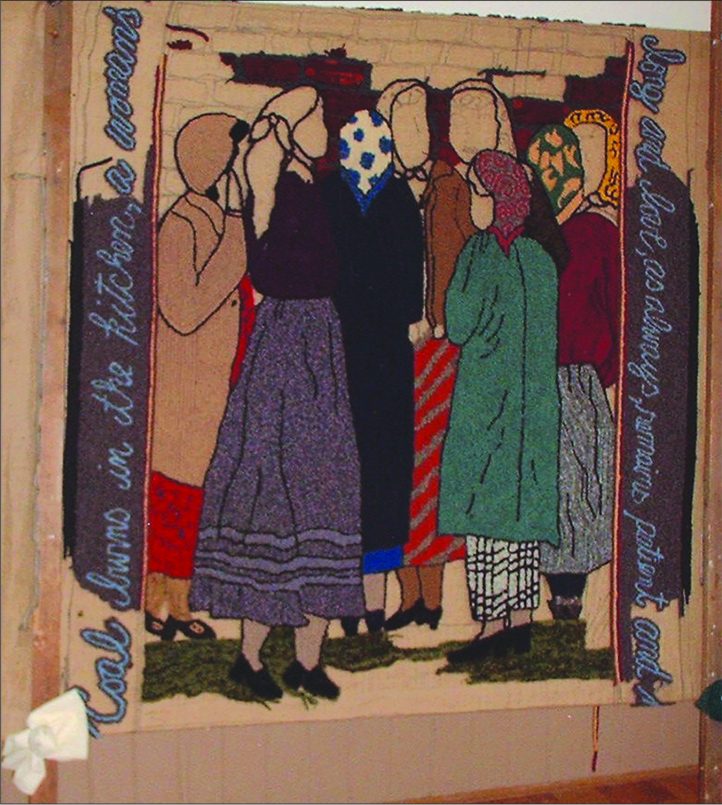
THE WOMEN WAITING AT THE PITHEAD, 5′ x 6′, #6 and 8-cut wool on burlap. Designed by Deanne Fitzpatrick. Hooked by the Springhill Rug Hooking Group, Springhill, Nova Scotia, 2005. PHOTOGRAPH COURTESY OF DEANNE FITZPATRICK
Becoming Involved in a Community Project
Whether you pursue rug hooking as a hobby, craft, or an art, there are tremendous opportunities to use it to build, develop, or just get involved in your community. Because it is something you love to do, it is also important to protect yourself and your art. I get many more requests for community involvement than I can pos-sibly meet. Many people will call for a donation of a rug, or to ask for your time to teach for free. It is important to decide which groups and causes are important to you and that you want to sup-port because you cannot support them all.
A good community project can develop in several ways. You can work for the good of the community carrying out a project yourself such as creating a rug to donate for a worthy cause. In this case it is important that the group you are donating to knows the value of hand-made hooked rugs and can successfully use it to raise funds. A rug can also be given as a gift of art to a public institution so that many people can enjoy it. Many public organizations have no budget for artwork but really appreciate the value of it on their walls. I have found this a good place for rugs that I cannot bear to sell, but no longer have the space for in my home.
If you are involved in a project that involves many people, one of the biggest challenges may be working together. It may be necessary to have a chair or coordinator who is good at making sure all the voices of the group are heard and incorporated. It is like working on any project together; building consensus and moving forward can be the real task ahead of you. In the projects I have discussed I learned that they were a success because members listened to and respected each other. Their motivation was in caring for each other as group members, caring for their community, and caring for the art of rug hooking.
Choose the projects you want to get involved in carefully because you do not want to turn this beautiful craft into “another thing that has to be done.” Use it wisely, but be sure to give it away when the time is right and it will, as the saying goes, come back to you tenfold.
